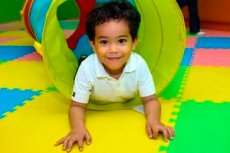Medical expert of the article
New publications
Activities with a child with alalia
Last reviewed: 04.07.2025

All iLive content is medically reviewed or fact checked to ensure as much factual accuracy as possible.
We have strict sourcing guidelines and only link to reputable media sites, academic research institutions and, whenever possible, medically peer reviewed studies. Note that the numbers in parentheses ([1], [2], etc.) are clickable links to these studies.
If you feel that any of our content is inaccurate, out-of-date, or otherwise questionable, please select it and press Ctrl + Enter.

In case of delayed speech development in children – motor, sensory or sensorimotor alalia – speech and communication skills need to be developed from the age of three to four, for which speech therapy classes are held with a child with alalia and expressive or receptive speech disorder.
Based on an individual approach to each child and taking into account the level of his speech development, the correction of alalia in preschoolers is carried out in the process of play, which promotes the development of cognitive abilities, motor skills and perception, the acquisition of basic linguistic forms and the enrichment of vocabulary, which has a positive effect on the dynamics of the development of speech functions. [ 1 ]
Speech therapy sessions with a child with motor alalia
For a child with motor alalia – an expressive speech disorder – speech therapy sessions are aimed at activating speech function and are designed to teach the child to recognize sounds, reproduce them adequately and use them for communication.
According to existing methods, the structure of classes includes:
- correction of sound pronunciation with the establishment of the correct use of the articulatory apparatus;
- formation of an understanding of the sound and syllabic structure of words;
- mastering the principles of word formation and inflection, as well as grammatical systems of language and speech;
- expanding vocabulary;
- teaching the rules for constructing phrases and simple sentences of different types.
As a rule, they begin by teaching the child to recognize, distinguish animal voices and imitate them.
Then short and simple words are learned - names of objects (body parts, toys, etc.), actions, signs (depicted or presented). Correcting omissions or rearrangement of syllables in words can take a lot of time, so frequent repetition of the correct pronunciation of syllables is necessary.
A special role in the formation of speech is played by memorizing and repeating short phrases of two or three words (noun + verb), necessary for the child’s everyday communication.
As the remedial work progresses, the tasks become more complex: they include learning to change words (nouns - by case, verbs - by tense), mastering new parts of speech and their agreement in sentences, constructing phrases from four to five words (using key words, a picture, etc.). [ 2 ]
Speech therapy sessions with a child with sensory alalia
For a child with sensory alalia – a disorder of receptive speech – speech therapy sessions are designed to improve understanding of speech as such, that is, to form connections between words and the objects they denote (concepts, actions, etc.).
In addition to improving understanding and developing targeted attention using verbal methods, the structure of classes with this type of speech development disorder is based on visual methods (using visual aids in the form of objects, pictures, models, layouts, etc.), which allow for increasing the effectiveness of developing phonemic perception of language, correct articulation when pronouncing sounds, and mastering the basics of the vocabulary and grammatical structure of speech. [ 3 ]
Speech therapy sessions with a child with sensorimotor alalia
Sensorimotor alalia is a severe speech and language disorder in a child due to damage to the speech centers of the cerebral cortex, which can be expressed in its impairment or complete absence.
With this type of alalia, speech therapy correction begins with teaching the child to perceive any sounds and form a response to them, and then the skills of recognizing them. And only after this do classes begin on mastering the phonetic-phonemic system of speech, comparing the visual and sound images of words (skills of identifying objects and their names), applying basic lexical and grammatical constructions, and expanding the so-called emotional vocabulary. [ 4 ]
The structure of classes for children with sensorimotor speech disorders should include tasks for the development of fine motor skills, articulation exercises, speech therapy massage, etc.
It should be noted that with sensorimotor alalia, it is rarely possible to form a vocabulary and teach children speech skills, since there are often signs of systemic cognitive impairment.
Read also:

